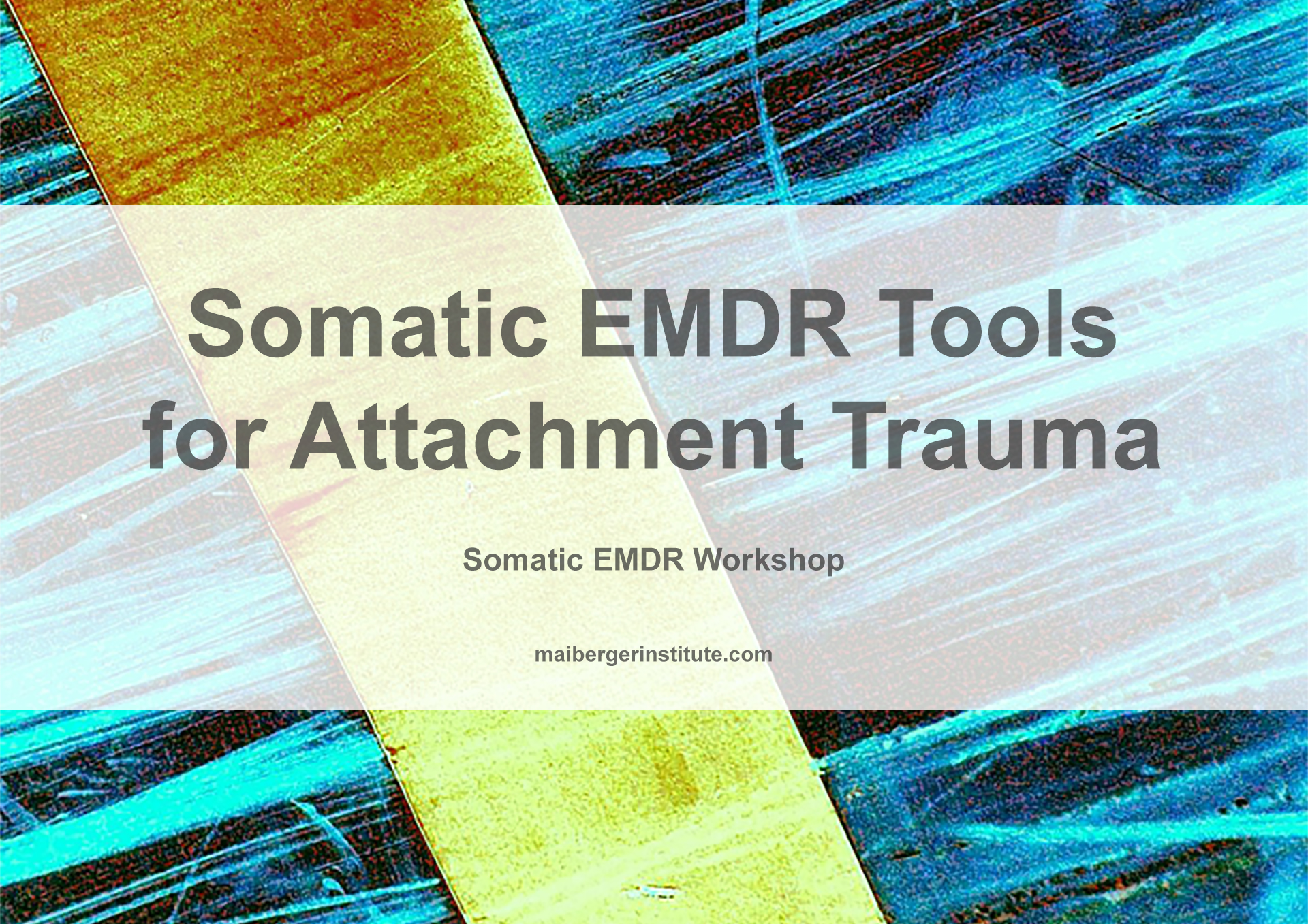When therapists are first learning EMDR Therapy, they quickly realize that single incident traumas easily reprocess, and more complex cases do not respond using the standard protocol without learning more skills to recognize the underlying Attachment trauma. In order to successfully navigate Attachment Trauma, EMDR Therapists need to learn how to work with Ego States, which I will refer to as “Parts.”

These experiences influence our thoughts and behaviors and can happen in different emotional developmental stages. Our bodies continue to grow up, while our emotional bodies are stunted at an earlier age. Have you ever had an experience where you feel like you are acting like a baby, or a child, or maybe even feel like a teenager? Then you may have experienced what I’m calling a “Part.” A “Part” of you took over how you were feeling and behaving, even though you know you are an adult.

When a parent is unable to provide this for their baby, there is a lack of attunement and a neural pathway is developed where the baby may feel anxious, scared, frustrated causing the baby pain. Shapiro states in her book that this can occur if the parent is overwhelmed, grieving, stuck in addictions, responding to the baby’s cues inappropriately, and can include abuse. Babies can grow up feeling: “I can’t get close to you because you might hurt me”, “it’s not safe to express my emotions because emotions aren’t welcome here,” “my needs never matter,” etc. Through this process the baby gets stuck in these beliefs and ways of relating which can impact relationships later in life.
Let’s take a look at an example of a 30 year old female who felt abandoned as a baby and it’s impacting her current relationship as an adult. Whenever her boyfriend goes out with his buddies, she feels very alone and anxious, afraid that he will leave her to find someone better than her. She rationally knows that he is loyal to her, and yet she is flooded with these emotions, irrational thoughts and fears. She doesn’t understand why she is feeling so out of control. In this example, a young wounded “Part” of her gets activated when her boyfriend goes out. Something happened to her in her childhood where that “Part” of her hasn’t grown up and is stunted in the trauma of the childhood experience.
Through further exploration, the therapist finds out that her mother was overwhelmed taking care of other children when she was a baby, so she wasn’t very available to attune to her needs. Her father was traveling for work a lot, so he just wasn’t around a lot. So as a baby she felt all alone and abandoned by her parents. This early imprint has become the template for her adult relationships. When her boyfriend goes out, the baby “Part” of her gets activated and all the original emotions come flooding in and taking over her rational adult self.
 With this understanding of Attachment, you can see how “Parts” may develop through this process of bonding or lack of bonding. In EMDR Therapy, the therapist has to recognize that the client may be struggling with a “Part” that is stuck in the past with the same emotions that are causing them pain now as an adult. Once the “Part” is recognized and named, for example, this is the “Baby Part”, the therapist has to help the client resource that “Part” by creating a team of allies. This team can consist of nurturing, protective and even wise figures. These figures can include spiritual figures, animals, characters from movies or books, trusted mentors, etc. The more the client has, the more secure and safe they feel. When the client has enough safety and protection, their nervous system relaxes and reparative experiences can occur. What was missing for the client then, can now be imagined to take place with this team of allies. It repairs the experience for the client, shifting and changing the neural pathway. It doesn’t change what really happened, but it changes the neurobiology so the client may find a new neural pathway to travel down.
With this understanding of Attachment, you can see how “Parts” may develop through this process of bonding or lack of bonding. In EMDR Therapy, the therapist has to recognize that the client may be struggling with a “Part” that is stuck in the past with the same emotions that are causing them pain now as an adult. Once the “Part” is recognized and named, for example, this is the “Baby Part”, the therapist has to help the client resource that “Part” by creating a team of allies. This team can consist of nurturing, protective and even wise figures. These figures can include spiritual figures, animals, characters from movies or books, trusted mentors, etc. The more the client has, the more secure and safe they feel. When the client has enough safety and protection, their nervous system relaxes and reparative experiences can occur. What was missing for the client then, can now be imagined to take place with this team of allies. It repairs the experience for the client, shifting and changing the neural pathway. It doesn’t change what really happened, but it changes the neurobiology so the client may find a new neural pathway to travel down.
In EMDR Therapy we can work with these early experiences even when there isn’t a clear memory. Learning how to work with Attachment Trauma is an essential skill to incorporate into EMDR Therapy treatment. Resourcing “Parts” can take some time in the Preparation Phase of EMDR Therapy and therapists sometimes get impatient with the process. But when a “Part” can have the correct resources, processing can be much gentler and more effective way with this earlier wounding, Once the “Part” renegotiates that earlier trauma, the “Part” begins to integrate into the Self and the client feels more whole and less triggered as an adult. They are able to stay more present in their current relationship. So the woman we talked about earlier would be able to see her boyfriend leaving, understanding that he is coming home and that she is okay. The fear, anxiety, and overwhelm dissipate allowing the client to feel more at peace in their life.
In our Somatic EMDR Workshop, “Somatic EMDR Tools for Attachment Trauma,” Dr. Arielle Schwartz and I created experiential exercises that EMDR Therapists will actually practice in the workshop, so that therapists can implement these tools immediately with their clients. The exercises include how to recognize when a “Part” is activated in therapy, as well as, how to resource that “Part” to have successful EMDR reprocessing. Therapists walk away with a deeper understanding of Attachment Theory and how to apply it to EMDR Therapy. Clients will feel more integrated and feel changes that are deep and lasting.
We hope you can attend “Somatic EMDR Tools for Attachment Trauma“to learn more about working with “Parts” and Attachment Trauma.
Learn more about “EMDR Therapy Tools for Attachment Trauma”
About Barb Maiberger, MA, LPC
 Barb Maiberger, MA, LPC is the founder of the Maiberger Institute, and the author of “Remote Together: A Therapist’s Guide to Cultivating a Sustainable Practice,” “EMDR Essentials: A Guide for Clients and Therapists and the co-author of “EMDR Therapy and Somatic Psychology: Interventions to Enhance Embodiment in Trauma Treatment.” Barb Maiberger is an EMDR Trainer and Consultant, and is the CE Program Administrator for the Maiberger Institute. She is a Licensed Professional Counselor in the State of Colorado and has a Masters degree in Somatic Psychology. Barb has personally conducted over a hundred EMDR Training programs. Barb’s knowledge, experience, keen sense of empathy, and a strong presence have motivated over a thousand therapists to incorporate EMDR Therapy into their practices.
Barb Maiberger, MA, LPC is the founder of the Maiberger Institute, and the author of “Remote Together: A Therapist’s Guide to Cultivating a Sustainable Practice,” “EMDR Essentials: A Guide for Clients and Therapists and the co-author of “EMDR Therapy and Somatic Psychology: Interventions to Enhance Embodiment in Trauma Treatment.” Barb Maiberger is an EMDR Trainer and Consultant, and is the CE Program Administrator for the Maiberger Institute. She is a Licensed Professional Counselor in the State of Colorado and has a Masters degree in Somatic Psychology. Barb has personally conducted over a hundred EMDR Training programs. Barb’s knowledge, experience, keen sense of empathy, and a strong presence have motivated over a thousand therapists to incorporate EMDR Therapy into their practices.
Related Somatic EMDR Workshop
Somatic EMDR Tools for Attachment Trauma
This two-day Somatic EMDR Workshop — created by Barb Maiberger and Dr. Arielle Schwartz, authors of “EMDR Therapy and Somatic Psychology: Interventions to Enhance Embodiment” — is designed to help EMDR therapists learn an integrative approach in working with Attachment trauma. Therapists learning EMDR therapy are not trained to work with attachment trauma in their initial training and the impact it has on the body and mind. Clients who experience preverbal memories can feel overwhelmed which can shut down reprocessing through dissociation and a disconnect from the body. Learning how to work with preverbal memories by incorporating somatic skills is an essential for all EMDR therapists who want to help their clients heal at a profound core level. Without effective treatment, attachment trauma can be passed onto the next generation. This work can help clients broaden their capacity to have healthy interpersonal relationships that can be fostered in the world. This workshop will be taught by Dr. Arielle Schwartz, who is highly skilled and brings her own unique experiences and wealth of knowledge into the workshop.
Click to Learn More…
[Image Source: “Boy, Toddler, Ceo, Child, Kid, Cute, Happy, Baby” by Courtany via Pixabay (CC)]






